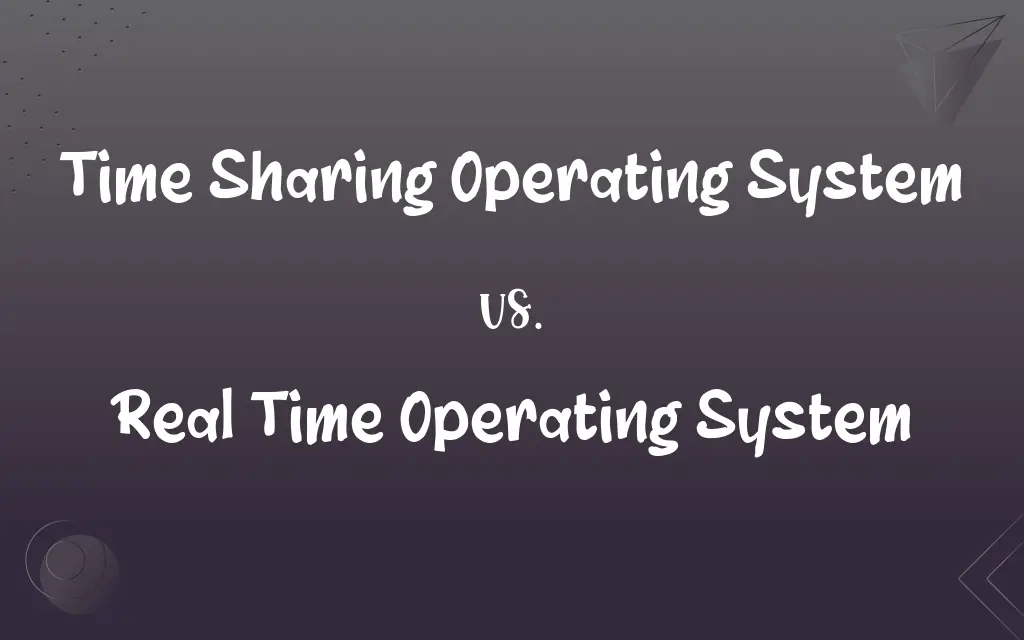Time Sharing Operating System vs. Real Time Operating System: What's the Difference?
Edited by Aimie Carlson || By Janet White || Published on February 20, 2024
Time-sharing operating systems allocate system resources to multiple users or processes on a time-sharing basis, while real-time operating systems prioritize processing data and responding to inputs within a guaranteed time frame.

Key Differences
Time-sharing operating systems are designed to provide a computing environment where multiple users can access the system resources simultaneously. The system allocates a specific time slot for each user or process, ensuring fair resource distribution. Real-time operating systems (RTOS), in contrast, are designed to handle events or data in a timely, predictable manner, crucial for applications that require precise timing and consistency, such as embedded systems.
In time-sharing operating systems, resource allocation is based on time slots, focusing on maximizing user interactions and system efficiency. These systems are ideal for general-purpose computing where the focus is on user experience and multitasking. Real-time operating systems prioritize tasks based on their urgency and deadlines, focusing on meeting time constraints and ensuring timely responses to events, which is essential for critical applications like medical systems or industrial control.
Time-sharing operating systems employ techniques like multitasking and process scheduling to manage multiple users and processes. They are commonly used in environments like servers, workstations, and personal computers where the goal is to optimize resource utilization and user productivity. Real-time operating systems, on the other hand, are streamlined for minimal process delays, often using preemptive scheduling to ensure high-priority tasks are completed on time, crucial for systems like air traffic control or automated manufacturing.
The performance of time-sharing operating systems is often measured by throughput and user responsiveness, focusing on how efficiently the system handles multiple concurrent users and tasks. Real-time operating systems are evaluated based on their ability to meet specific timing constraints, including deadlines and response times, which is critical for ensuring the correct functioning of real-time applications.
Time-sharing operating systems are versatile and suitable for a broad range of general computing tasks, they may not be appropriate for applications requiring strict timing constraints. Real-time operating systems are specialized for scenarios where timing and reliability are paramount, but they might not be as flexible or efficient for general-purpose computing tasks.
ADVERTISEMENT
Comparison Chart
Primary Focus
Maximizing user interactions and multitasking.
Meeting strict timing constraints.
Resource Allocation
Based on time slots for fairness.
Based on task urgency and deadlines.
Ideal Use Case
General-purpose computing, servers, PCs.
Critical time-sensitive applications.
Performance Measurement
Throughput and user responsiveness.
Ability to meet deadlines and response times.
Suitability for General Computing
Highly suitable for a range of tasks.
Less flexible for non-time-critical tasks.
ADVERTISEMENT
Time Sharing Operating System and Real Time Operating System Definitions
Time Sharing Operating System
It efficiently manages system resources among multiple users.
The company's server runs a time-sharing operating system to handle requests from hundreds of employees.
Real Time Operating System
An OS designed to process data in real-time with predictable response times.
A real-time operating system is crucial for the accurate functioning of an autonomous vehicle.
Time Sharing Operating System
Maximizes CPU usage by dividing time into intervals for each task.
Time-sharing operating systems ensure that no single user monopolizes the CPU.
Real Time Operating System
Minimizes process latency and handles concurrent tasks efficiently.
A real-time operating system in a factory robot coordinates tasks for precision and speed.
Time Sharing Operating System
Balances system performance and user response time.
The mainframe’s time-sharing operating system balances the workload among various departments.
Real Time Operating System
Often used in embedded systems where timing is crucial.
Aircraft control systems rely on real-time operating systems for immediate response.
Time Sharing Operating System
A system that allows multiple users to use a computer simultaneously.
Universities often use time-sharing operating systems to allow many students to access the same server.
Real Time Operating System
It prioritizes tasks based on their urgency and importance.
In medical devices, a real-time operating system ensures critical tasks are processed immediately.
Time Sharing Operating System
Provides the illusion of multiple CPUs by rapid context switching.
Time-sharing operating systems make users feel they have the computer to themselves.
Real Time Operating System
Ensures system reliability and stability in time-sensitive environments.
Traffic light control systems use real-time operating systems for synchronized operations.
FAQs
What is a real-time operating system (RTOS)?
An OS designed to handle tasks in real-time with predictable response times.
What is the main feature of an RTOS?
Its ability to process data and respond to inputs within a guaranteed time frame.
How does a time-sharing OS handle multiple users?
It allocates time slots to each user or process, enabling concurrent access.
Where is a time-sharing OS typically used?
In environments like universities, businesses, and servers for multiple user access.
Where is an RTOS typically used?
In critical applications like medical systems, industrial control, and embedded systems.
How does an RTOS manage resources?
By focusing on minimal delays and predictable scheduling for high-priority tasks.
What is a time-sharing operating system?
A system allowing multiple users to access computer resources simultaneously by time-sharing.
How does an RTOS prioritize tasks?
Based on urgency and deadlines, using preemptive scheduling.
Can a time-sharing OS handle real-time tasks?
It's not ideal for real-time tasks due to less predictable response times.
Is an RTOS suitable for general computing?
No, it's specialized for time-sensitive tasks and less flexible for general computing.
Is an RTOS more complex than a time-sharing OS?
Yes, due to its requirement for precise timing and reliability.
How does a time-sharing OS ensure fairness?
By allocating equal time slots to each task or user.
What is the main advantage of a time-sharing OS?
Efficient multitasking and resource utilization among multiple users.
What is the main advantage of an RTOS?
Reliable and timely execution of critical, time-sensitive tasks.
How does a time-sharing OS manage resources?
Through multitasking and process scheduling based on time.
What type of scheduling is used in a time-sharing OS?
Typically round-robin or other fair scheduling algorithms.
What type of scheduling is used in an RTOS?
Preemptive scheduling based on task priority and deadlines.
Can a time-sharing OS be used in embedded systems?
It's not optimal due to the less predictable timing of task execution.
Do time-sharing OSes focus on user interaction?
Yes, they are designed to optimize user experience and responsiveness.
Are RTOSes used in everyday computing devices?
Typically, they are used in specialized devices rather than everyday computing.
About Author
Written by
Janet WhiteJanet White has been an esteemed writer and blogger for Difference Wiki. Holding a Master's degree in Science and Medical Journalism from the prestigious Boston University, she has consistently demonstrated her expertise and passion for her field. When she's not immersed in her work, Janet relishes her time exercising, delving into a good book, and cherishing moments with friends and family.
Edited by
Aimie CarlsonAimie Carlson, holding a master's degree in English literature, is a fervent English language enthusiast. She lends her writing talents to Difference Wiki, a prominent website that specializes in comparisons, offering readers insightful analyses that both captivate and inform.







































































